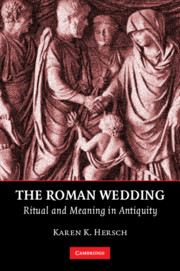5 - Conclusion
Published online by Cambridge University Press: 05 June 2012
Summary
If the Romans viewed the symbols of their wedding in the way that the assembled evidence suggests they did, then they would have found much to appreciate in the trajectory of the standard modern American wedding. Of course, American brides and grooms, like their Roman counterparts, may choose different adornments or decorations depending on their taste, religion, ethnicity, or financial situation. But if the white dresses in the window of any given bridal shop or on the cover of Brides magazine on any given month are a guide to what most brides in this country prefer at the time of this writing, then modern brides too choose to clothe themselves in fabric symbolic of purity, whatever the status of their virginity. Moreover, because most of these grand white dresses represent a distinctly “Western” cut, anyone could argue that they represent a distinctly Western purity. In contrast, the American groom is likely to be identifiable by a suit differing only in price from those worn by his male guests; indeed, he may be distinguished from other men only by a boutonniere. Unlike the ancient or the modern bride, who was or is immediately recognizable by her flammeum or elaborate white dress and veil, respectively, and who presumably never wears her wedding finery again, the Roman groom probably did wear his shining white garment again to parties, as can the American groom recycle his tuxedo or fine suit for wear at elegant parties, other weddings, or indeed to perform music solo or in an orchestra.
- Type
- Chapter
- Information
- The Roman WeddingRitual and Meaning in Antiquity, pp. 289 - 304Publisher: Cambridge University PressPrint publication year: 2010

